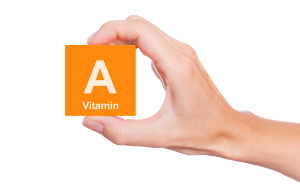Vitamin E (tocopherol)
 Vitamin was originally isolated from wheat germ oil in 1936. The nutrient is a lipid-soluble vitamin of vegetable origin that is primarily found in fatty foods. Vitamin E includes eight different compounds called tocopherols and tocotrienols. Alpha-tocopherol is considered the most important type of vitamin E for humans, as it is the most prevalent and active form of the nutrient. The largest concentrations are found in the adrenal glands, testicles, uterus, and fatty tissues. Vitamin E is destroyed by light and freezing. Oils should be stored in a dark and cool place.
Vitamin was originally isolated from wheat germ oil in 1936. The nutrient is a lipid-soluble vitamin of vegetable origin that is primarily found in fatty foods. Vitamin E includes eight different compounds called tocopherols and tocotrienols. Alpha-tocopherol is considered the most important type of vitamin E for humans, as it is the most prevalent and active form of the nutrient. The largest concentrations are found in the adrenal glands, testicles, uterus, and fatty tissues. Vitamin E is destroyed by light and freezing. Oils should be stored in a dark and cool place.
Functions and importance for
- Antioxidant that counteracts free radicals in collaboration with other antioxidants (especially selenium)
- Protects fatty cell surfaces and lipids against lipid peroxidation (rancidification)
- Protects the body's cells against harmful byproducts of the fat metabolism
- Cell growth and cell function
- Inhibits blood coagulation (lumping/clotting)
- Immune defence
- Inhibits the intestinal conversion of nitrate to nitrosamine, a process that is known to cause cancer
Deficiency and poor utilisation may be caused by
- Low-fat diets and poor fat absorption
- Diseases in the liver or pancreas where digestive enzymes have difficulty with breaking down vitamin E rich fats in the diet. Other factors include liver cirrhosis, celiac disease (gluten allergy), cystic fibrosis, and pancreatitis.
- Weight loss products like Orlistat/Xenical that inhibit the uptake of fat and fat-soluble vitamins
- Hereditary diseases of the red blood cells
- Prematurely born infants
Deficiency symptoms
In reality, deficiency symptoms do not occur in healthy humans.
- Babies who are given infant formula without vitamin E may develop skin lesions
- Babies born with diseases that involve impaired fat uptake develop symptoms of the nervous system relatively soon
- Extended periods of vitamin D deficiency may cause symptoms of the nervous system that include muscle fatigue and balance and vision disturbances
Sources
As vitamin E is lipid-soluble it is present in the dietary fats and especially in vegetable sources like plant oils, nuts, kernels, seeds, whole-grain, avocado, and green vegetables such as broccoli and Brussels sprouts. Other sources are cod liver oil, cod roe, eggs, fatty dairy products, and human breastmilk. Many supplements contain synthetic forms of vitamin E, while others contain the natural and more active form.
Vitamin E content in mg per 100 grams
| Wheat germ oil | 153 |
| Sunflower seeds | 50 |
| Cod liver oil | 30 |
| Egg yolk and kale | 5 |
| Cream | 0.2 |
Recommended daily allowance (RDA)
Adults: 11 years of age and older: 12 mg
Children: 1-10 years of age: 5 mg
Measuring units
Milligrams (mg), alpha TE (alpha tocopherol) or international units (IU)
1 mg and 1 alpha TE = 1.49 IU.
Synthetic vitamin E contra natural vitamin E
- Synthetic vitamin E (starting with "dl") is only absorbed one third as effectively as natural vitamin E (starting with "d")
- Natural vitamin E may be named d-alpha tocopherol
- Synthetic vitamin E may be named dl-alpha tocopherol
Increased need and treatment of vitamin E deficiency
- The above mentioned deficiency symptoms
- Symptoms of a vitamin E deficiency are treated with daily doses of 200-400 mg of vitamin E
- People with impaired fat absorption are given double dosage and regular blood samples are taken in order to monitor blood levels of the nutrient
- Prematurely born babies and babies who are underweight (less than 1,500 grams) must be given five mg daily from their first week and up to the point where they weigh 2,000 grams in order to prevent the development of anemia.
Contraindications of strong vitamin E supplements
As vitamin E inhibits blood coagulation (lumping/clotting of blood platelets), strong vitamin E supplements are not advised with the following conditions and with simultaneous use of the following medical drugs:
- Blood-thinning medication
- Acetylsalicylic acid preparations
- Cholesterol-lowering drugs (statins)
- Risk of cerebral hemorrhage
- Conditions with vitamin D deficiency
- Two weeks before and two weeks after surgery
There is no risk involved with taking a regular vitamin pill that contains the RDA level of vitamin E. If in doubt, ask the physician.
Overdosing - side effects
Excess vitamin E is excreted in the bile and symptoms of overdosing are rarely seen. Long periods of ingesting dosages of more than 400-800 IU (around 250-500 mg) of vitamin E have been linked to dizziness, headaches, fatigue, and blurry vision. More than 1 gram daily (around 80 times more than the RDA level) may lead to headache and gastro-intestinal symptoms in rare cases. High dosages are suspected of increasing bleeding tendency. Ingestion of extreme dosages (10 grams daily) may reduce fertility in both men and women.
- Created on .












 "After about one week of taking the Q10 supplement I could feel a huge difference," says 23-year old Alan Piccini, who has been suffering from extreme fatigue and muscle aches ever since he was a child.
"After about one week of taking the Q10 supplement I could feel a huge difference," says 23-year old Alan Piccini, who has been suffering from extreme fatigue and muscle aches ever since he was a child. “Taking capsules with co-enzyme Q10 has freed me of the severe side effects of my cholesterol lowering medicine,” Mrs Franken explains.
“Taking capsules with co-enzyme Q10 has freed me of the severe side effects of my cholesterol lowering medicine,” Mrs Franken explains.